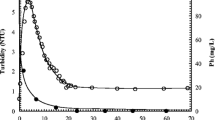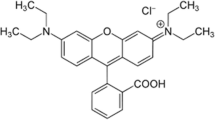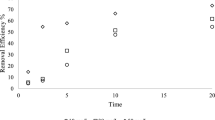Abstract
This paper deals with the changes of turbidity that are generated in aqueous solutions of phenol when they are oxidized by using different Fenton technologies. Results revealed that if the Fenton reaction was promoted with UV light, the turbidity that was generated in the water doubled. Alternatively, the use of ultrasonic waves produced an increase in turbidity which initially proceeded slowly, reaching intensities eight times higher than in the conventional Fenton treatment. As well, the turbidity showed a high dependence on pH. It is therefore essential to control acidity throughout the reaction. The maximum turbidity was generated when operating at pH = 2.0, and it slowly decreased with increasing to a value of pH = 3.0, at which the turbidity was the lowest. This result was a consequence of the presence of ferric ions in solution. At pH values greater than 3.5, the turbidity increased almost linearly until at pH = 5.0 reached its maximum intensity. In this range, ferrous ions may generate an additional contribution of radicals that promote the degradation of the phenol species that produce turbidity. Turbidity was enhanced at ratios R = 4.0 mol H2O2/mol C6H6O. This value corresponds to the stoichiometric ratio that leads to the production of turbidity-precursor species. Therefore, muconic acid would be a species that generate high turbidity in solution according to its isomerism. Also, the results revealed that the turbidity is not a parameter to which species contribute additively since interactions may occur among species that would enhance their individual contributions to it. Analyzing the oxidation of phenol degradation intermediates, the results showed that meta-substituted compounds (resorcinol) generate high turbidity in the wastewater. The presence of polar molecules, such as muconic acid, would provide the structural features that are necessary for resorcinol to act as a clip between two carboxylic groups, thus establishing directional hydrogen bonds that would generate an adduct in the 2:2 ratio. In addition, some similarity is observed between the turbidity and the presence of dihydroxybenzoquinone. This molecule has a structure that could establish hydrogen bond links with the carboxylic groups in 1:2 ratio. Such supramolecular structures would possess high molecular weight and robustness that would hinder the passage of light through the water, generating high turbidity.







Similar content being viewed by others
References
Biradha K, Santra R (2013) Crystal engineering of topochemical solid state reactions. Chem Soc Rev 42:950–967. doi:10.1039/C2CS35343A
Chan KH, Chu W (2003) Modeling the reaction kinetics of Fenton’s process on the removal of antrazine. Chemosphere 51:305–311. doi:10.1016/S0045-6535(02)00812-3
Cheng Y, Sun H, Jin W, Xu N (2007) Photocatalytic degradation of 4-chlorophenol with combustion synthesized TiO2 under visible light irradiation. Chem Eng J 128:127–133. doi:10.1016/j.cej.2006.09.009
Devlin HP, Harris IJ (1984) Mechanism of the oxidation of aqueous phenol with dissolved oxygen. Ind Eng Chem Fundam 23:387–392. doi:10.1021/i100016a002
Eisenhauer HR (1964) Oxidation of phenolic wastes: i. oxidation with hydrogen peroxide and a ferrous salt reagent. J. Water Pollut. Control Fed 36:1116–1128
Fortune WB, Mellon MG (1938) Determination of iron with o-phenanthroline. A spectrophotometric study. Ind Eng Chem Anal Ed 10:6064. doi:10.1021/ac50118a004
Ghioureliotis M, Nicell JA (2000) Toxicity of soluble products from the peroxidase-catalysed polymerization of substituted phenolic compounds. J Chem Technol Biotechnol 75:98–106
Gozzo F (2001) Radical and non-radical chemistry of the Fenton-like systems in the presence of organic substrates. J Mol Catal A Chem 171:1–22. doi:10.1016/S1381-1169(01)00099-1
Habicht J, Mäeorg U (2014) Coupling of resorcinols in retorted kukersite semi-coke. Environ Chem 63(1):75–85. doi:10.3176/proc.2014.1.10
Hynes MJ, O’Coinceanainn M (2001) The kinetics and mechanisms of the reaction of iron(III) with gallic acid, gallic acid methyl ester and catechin. J Inorg Biochem 85:131–142. doi:10.1016/S0162-0134(01)00205-7
Hynes MJ, O’Coinceanainn M (2004) The kinetics and mechanism of reactions of iron(III) with caffeic acid, chlorogenic acid, sinapic acid, feluric acid and naringin. J Inorg Biochem 98:1457–1464. doi:10.1016/j.jinorgbio.2004.05.009
Lindsey ME, Xu G, Lu J, Tarr MA (2003) Enhanced Fenton degradation of hydrophobic organics by simultaneous iron and pollutant complexation with cyclodextrins. Sci Total Environ 307:215–229. doi:10.1016/S0048-9697(02)00544-2
Liu Y, Zhu Y, Xu J, Bai X, Zong R, Zhu Y (2013) Degradation and mineralization mechanism of phenol by BiPO4 photocatalysis assisted with H2O2. Appl Catal B-Environ 142–143:561–567. doi:10.1016/j.apcatb.2013.05.049
Matsumoto M, Suzuki M, Kano H, Aiso S, Yamazaki K, Fukushima S (2012) Carcinogenicity of ortho-phenylenediamine dihydrochloride in rats and mice by two-year drinking water treatment. Arch Toxicol 86:791–804. doi:10.1007/s00204-012-0800-z
Mijangos F, Varona F, Villota N (2006) Changes in solution color during phenol oxidation by Fenton reagent. Environ Sci Technol 40:5538–5543. doi:10.1021/es060866q
Najafi M, Khalilzadeh MA, Karimi-Maleh H (2014) A new strategy for determination of bisphenol A in the presence of Sudan I using a ZnO/CNTs/ionic liquid paste electrode in food samples. Food Chem 158:125–131. doi:10.1016/j.foodchem.2014.02.082
Neyens E, Baeyens J (2003) A review of classic Fenton’s peroxidation as an advanced oxidation technique. J Hazard Mater 98(1–3):33–50. doi:10.1016/S0304-3894(02)00282-0
Oller I, Malato S, Sánchez-Pérez JA (2011) Combination of advanced oxidation processes and biological treatments for wastewater decontamination—a review. Sci Total Environ 409:4141–4166. doi:10.1016/j.scitotenv.2010.08.061
Pignatello JJ (1992) Dark and photoassisted Fe (III)-catalyzed degradation of chlorophenoxy herbicides by hydrogen peroxide. Environ Sci Technol 26:944–951. doi:10.1021/es00029a012
Rasalingam S, Kibombo HS, CM W, Peng R, Baltrusaitis J, Koodali RT (2014) Competitive role of structural properties of titania-silica mixed oxides and a mechanistc study of the photocatalytic degradation of phenol. Appl Catal B Environ:148-149–394-405. doi:10.1016/j.apcatb.2013.11.025
Rodríguez E, Encinas A, Masa FJ, Beltran FJ (2008) Influence of resorcinol chemical oxidation on the removal of resulting organic carbon by activated carbon adsorption. Chemosphere 70:1366–1374. doi:10.1016/j.chemosphere.2007.09.035
Rodríguez EM, Núñez B, Fernández G, Beltrán FJ (2009) Effects of some carboxylic acids on the Fe(III)/UVA photocatalytic oxidation of muconic acid in water. Appl Catal B Environ 89(1–2):214–222. doi:10.1016/j.apcatb.2008.11.030
Rodríguez E, Mimbrero M, Masa FJ, Beltrán FJ (2007) Homogeneous iron-catalyzed photochemical degradation of muconic acid in water. Water Res 41(6):1325–1333. doi:10.1016/j.watres.2006.12.007
Rueda-Márquez JJ, Sillanpää M, Pocostales P, Acevedo A, Manzano MA (2015) Post-treatment of biologically treated wastewater containing organic contaminants using a sequence of H2O2 based advanced oxidation processes: photolysis and catalytic wet oxidation. Water Res 71:85–96. doi:10.1016/j.watres.2014.12.054
Santos A, Yustos P, Quintanilla A, García-Ochoa F (2004) Lower toxicity route in catalytic wet oxidation of phenol at basic pH by using bicarbonate media. Appl Cat B-Environ 53(3):181–194. doi:10.1016/j.apcatb.2004.04.022
Santos A, Yustos P, Quintanilla A, Rodríguez S, García-Ochoa F (2002) Route of the catalytic oxidation of phenol in aqueous phase. Appl Cat B-Environ 39:97–113. doi:10.1016/S0926-3373(02)00087-5
Scheck CK, Frimmel FH (1995) Degradation of phenol and salicylic acid by ultraviolet radiation/hydrogen peroxide/oxygen. Water Res 29(10):2346–2352. doi:10.1016/0043-1354(95)00060-X
Silva LMC, Salgado AM, Coelho MAZ (2011) Development of an amperometric biosensor for phenol detection. Environ Technol 32:493–497. doi:10.1080/09593330.2010.504234
Song Y, Xie J, Shu H, Zhao G, Lva X, Caic H (2005) Density-functional theory and ab initio Hartree–Fork studies on the structural parameters and chemical activity of the free radicals generated by benzoquinone and hydroquinone. Bioorg Med Chem 13:5658–5667. doi:10.1016/j.bmc.2005.05.029
Villota N, Camarero LM, Lomas JM, Legaristi M (2014a) Kinetic modelling of photoconversion of phenol by a photo-Fenton reagent and UV. Int J Chem React Eng 12(1):405–416. doi:10.1515/ijcre-2013-0130
Villota N, Camarero LM, Lomas JM, Pérez J (2014b) Changes of turbidity during the phenol oxidation by photo-Fenton treatment. Environ Sci Pollut Res 21(21):12208–12216. doi:10.1007/s11356-014-3017-2
Villota N, Camarero LM, Lomas JM, Pérez-Arce J (2015) The role of iron species on the turbidity of oxidized phenol solutions in a photo-Fenton system. Environ Technol 5:1–9. doi:10.1080/21622515.2015.1013573
Wu C, Liu Z, Sun H, Wang X, Xu P (2016) Selective determination of phenols and aromatic amines based on horseradish peroxidase-nanoporous gold co-catalytic strategy. Biotechnol Bioeng 79:843–849. doi:10.1016/j.bios.2016.01.026
Yamahara R, Ogo S, Masuda H, Watanabe Y (2002) (Catecholato)iron(III) complexes: structural and functional models for the catachol-bound iron(III) form of catechol dioxygenases. J Inorg Biochem 88:284–294. doi:10.1016/S0162-0134(01)00353-1
Zazo JA, Casas JA, Mohedano AF, Gilarranz MA, Rodríguez JJ (2005) Chemical pathway and kinetics of phenol oxidation by Fenton’s. Reagent. Environ Sci Technol 39:9295–9302. doi:10.1021/es050452h
Zepp RG, Faust BC, Hoigne J (1992) Hydroxyl radical formation in aqueous reaction (pH = 3-8) of iron(II) with hydrogen peroxide: the photo-Fenton reaction. Environ Sci Technol 26:313–319. doi:10.1021/es00026a011
Author information
Authors and Affiliations
Corresponding author
Additional information
Responsible editor: Angeles Blanco
Rights and permissions
About this article
Cite this article
Villota, N., JM, L. & LM, C. Effect of substituted hydroxyl groups in the changes of solution turbidity in the oxidation of aromatic contaminants. Environ Sci Pollut Res 24, 1105–1112 (2017). https://doi.org/10.1007/s11356-016-7245-5
Received:
Accepted:
Published:
Issue Date:
DOI: https://doi.org/10.1007/s11356-016-7245-5




